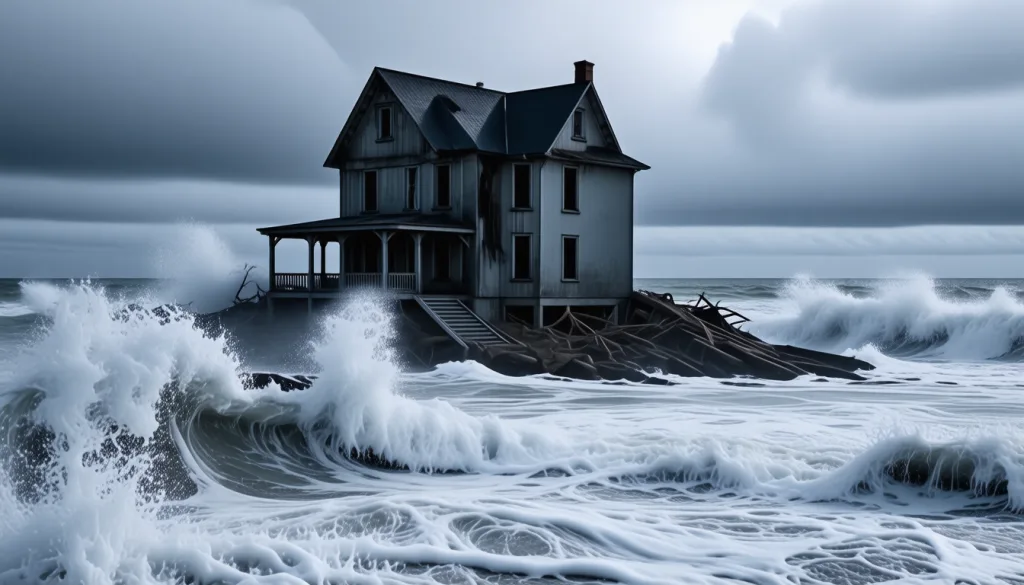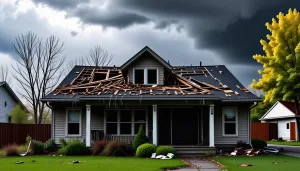The cost associated with storm damage restoration can vary significantly, influenced by a multitude of factors that dictate both immediate and long-term financial implications. Understanding these determinants is crucial for homeowners aiming to effectively manage and mitigate costs associated with storm impacts. These factors are not only pivotal in shaping the restoration expenses but also affect decisions regarding insurance claims and home safety investments.
Firstly, the type and severity of the storm play a critical role. Hurricanes, tornadoes, and floods each present unique challenges and levels of destruction, resulting in different restoration costs. For instance, hurricanes often cause extensive wind damage and flooding, requiring comprehensive repairs and potential structural reinforcements. In contrast, tornadoes may lead to localized but severe damages, such as roof replacement or complete rebuilds of severely impacted areas.
Another significant factor is the geographical location of the property. Homes located in regions prone to severe weather events, such as coastal areas or tornado alley, generally face higher storm damage restoration costs. This is due to increased vulnerability coupled with possible additional protections or renovations needed to enhance home safety and resilience against future storms. Additionally, supply and demand can drive prices up after a major storm, as the influx of repair requests may exceed local contractors’ capacity.
The condition and age of the home also significantly affect restoration expenses. Older homes or those not built to withstand severe weather are typically more vulnerable to damage, and thus require more costly repairs. Likewise, materials used in the original construction can influence repair costs, as certain materials may be pricier or harder to replace.
Furthermore, accessibility and the scope of damage within the property influence costs. If heavy equipment is needed, such as cranes to repair roof damage on a multi-story building, the restoration expenses will increase. The extent of the damage—whether it’s confined to a single area or involves widespread communal infrastructure like roads and utilities—also plays a crucial role in determining the overall financial burden.
Finally, regulatory requirements and local building codes might necessitate modifications to current structures during restoration, which can add to the cost. Compliance with updated codes ensures enhanced safety and resilience but can result in higher expenditures upfront.
To better illustrate how these factors can lead to differing restoration costs, consider the following comparative table, which outlines potential expenses for various scenarios:
| Factor | Low-End Cost Estimate | High-End Cost Estimate |
| Type of Storm | Windstorm ($3,000) | Hurricane ($75,000) |
| Geographical Location | Midwest ($2,500) | Coastal ($50,000) |
| Age and Condition of Home | Modern/Sound ($10,000) | Old/Weak ($30,000) |
| Accessibility/Scope of Damage | Minor/Localized ($5,000) | Major/Widespread ($100,000) |
| Regulatory Changes | Not Needed ($0) | Comprehensive ($20,000) |
Being aware of these factors not only helps in anticipating the potential costs involved in storm damage restoration but also aids in planning and implementing proactive measures to safeguard property and ensure home safety. By doing so, homeowners can minimize both immediate expenditures and longer-term financial liabilities.
Breakdown of restoration expenses
When breaking down the expenses associated with storm damage restoration, it’s essential to consider both the direct and indirect costs that homeowners may incur. This analysis can help you prepare better financially and ensure that you cover all necessary aspects when planning for restoration.
1. Initial Assessment and Inspection Fees
The first step in the restoration process is a thorough assessment of the storm damage, which typically requires professional evaluation:
– A certified inspector or structural engineer may be necessary if there are signs of significant structural damage.
– Assessment fees can vary depending on the complexity and location of the damage, generally ranging from $200 to $1,000.
– The inspection report will outline the scope of necessary repairs and help prioritize urgent versus non-urgent tasks.
2. Debris Removal and Disposal Costs
Removing debris is a crucial step before any repair or reconstruction work can begin:
– Costs for debris removal can depend on the volume and type of materials, with smaller cleanups costing a few hundred dollars and larger ones potentially exceeding $1,000.
– This phase might involve hazardous waste removal, which could lead to additional charges.
3. Water and Mold Remediation
Water intrusion and subsequent mold growth are common issues following storms, especially floods:
– Water extraction can range from $500 to $3,000 depending on the severity and size of the area affected.
– Mold remediation, which includes removing and treating mold-infested areas, can cost between $500 and $6,000.
– Early detection and remediation are vital to maintaining home safety and preventing health risks.
4. Structural Repairs and Building Material Costs
The bulk of restoration expenses typically arise from structural repairs:
– Roof repairs or replacements can cost from $5,000 to $30,000 depending on the extent of damage and materials used.
– Siding repair costs vary but can average $1,000 to $15,000, influenced by material type and coverage area.
– In severe cases, foundation repairs might be necessary, potentially adding $10,000 to $50,000 to the expenses.
5. Electrical and Plumbing Repairs
Storm damage can also impact your home’s electrical and plumbing systems:
– Electrical repairs, ranging from fixing circuits to rewiring, may cost anywhere from $500 to $10,000.
– Plumbing repairs, especially in flood situations, can range from $1,000 to $5,000, depending on the necessary work scope.
6. Interior Restorations
Storms often lead to interior damage depending on the severity and location:
– Drywall repairs or replacement might cost between $1,000 and $4,000.
– Flooring repairs or replacements can add another $2,000 to $10,000 depending on the material (carpet, hardwood, tile).
7. Landscaping and Exterior Features
Rejuvenating the exterior elements can come as additional expenses:
– Tree removal or landscape repairs can range from $500 to $5,000.
– Fencing repairs or replacement can cost between $1,000 and $4,000, especially if it involves specialized materials or designs.
8. Regulatory and Compliance Costs
In some instances, local law may require compliance with updated building codes:
– Depending on these regulations, homeowners may need to invest in upgrades or alterations, potentially adding significant costs.
Each step in the restoration process adds up to the overall expense, and understanding these components allows homeowners to better manage these disruptions. Knowing these details can guide you through negotiations with contractors, discussions with insurers, and help you make informed decisions about balancing cost against quality and home safety enhancements.
Insurance coverage and out-of-pocket costs
When assessing the financial burdens that come with storm damage restoration, understanding the interplay between insurance coverage and out-of-pocket expenses is essential for homeowners. Insurance policies can greatly influence how much restoration will personally cost you, making it crucial to navigate these details carefully.
Firstly, homeowners’ insurance typically covers certain kinds of storm damage, but the specifics can vary based on your policy. For instance, standard policies usually cover wind damage but might exclude flooding, a common result of severe storms. This means that if your home is located in a flood-prone area, you may need to purchase separate flood insurance. Reading the fine print of your policy can help you identify exactly what types of damage are covered and what are not, allowing you to make informed decisions ‘pre-storm’ whenever possible.
Deductibles are a key component of how much you’ll pay out-of-pocket, with higher deductibles often leading to a reduced annual premium but increasing your responsibility when filing a claim. It’s also worth noting that some policies have separate deductibles specifically for wind or hurricane damage, which are often calculated as a percentage of the total insured value of your home.
Insurance adjusters will typically evaluate the damage and determine the reimbursable amount based on your policy coverage. However, expenses like code upgrades (required to meet newer local building regulations) and some luxury item repairs might come directly out of your pocket unless specifically covered in your policy. Maintaining clear communication with your insurer throughout this process is crucial to avoiding unpleasant surprises.
Additionally, actual cash value (ACV) versus replacement cost value (RCV) coverage can significantly affect out-of-pocket costs. ACV policies take depreciation into account, potentially leaving you responsible for the gap between the depreciated value and the repair costs. On the other hand, RCV policies offer reimbursement based on the cost to repair or replace the property without considering depreciation, generally resulting in a higher premium but less out-of-pocket expense during the restoration.
Filing a claim also involves providing detailed documentation of the damages and the associated costs. It’s advisable to document everything meticulously and to keep receipts of repairs and restorations for the insurance company. Furthermore, some homeowners might choose to handle minor repairs independently and only file claims for substantial damages, which can help in maintaining favorable insurance premiums in the long run by not signaling elevated risk to insurers.
Understanding these aspects of insurance coverage will help not only in budgeting for the restoration process but also in strategically managing out-of-pocket costs. This knowledge ultimately empowers homeowners to better protect their investments in home safety and ensures more resilient property management in anticipation of future storms.
Cost-saving tips for storm restoration
Navigating the expenses associated with storm damage restoration can seem overwhelming, yet there are several effective strategies homeowners can employ to mitigate these costs without compromising on quality or home safety.
One of the most practical approaches for reducing restoration expenses is proactive preparedness. Investing in preventive measures before a storm strikes can save significant money in potential repairs. Homeowners might consider installing storm shutters to protect windows or reinforcing their roofs to withstand high winds, both of which can greatly reduce susceptible damage from storms. Likewise, maintaining the landscape surrounding your property by trimming overhanging branches or removing dead trees can prevent external elements from contributing to additional damage during a storm.
When restoration becomes necessary, shop smart for contractors. It’s important to obtain multiple bids and have detailed discussions about the scope of work, materials needed, and expected timelines. This competitive approach not only helps find cost-effective pricing but also ensures transparency in what specific restoration tasks entail. Checking references and using contractors known for high standards can prevent quality-related issues later on.
Salvaging materials when feasible can also significantly cut costs. Depending on the extent of the damage, parts of your home such as bricks, tiles, or fixtures might be reusable. A contractor experienced with restoration work can advise on which materials can be salvaged without compromising the structural integrity or aesthetics of your home.
Considering economies of scale can be another cost-saving avenue. During wide-reaching restoration efforts (common after large storms), working collaboratively with neighbors to negotiate bulk services from contractors might land more favorable rates. Whether it’s a shared service for roof replacements or collective debris removal, aligning efforts can lead to discounts.
Utilizing government or community programs can provide helpful financial relief. Depending on your location, you may qualify for assistance or tax incentives designed to encourage disaster preparedness and risk mitigation. Programs such as these are particularly valuable when they align with investments in enhancing home resilience.
Moreover, understanding your insurance coverage is paramount. Ensure you’re maximizing the benefits available through your policy by having thorough discussions with your insurance provider about your specific storm damage needs. For example, some insurers offer discounts for homes with certified impact-resistant materials or updated protective installations. Always review your policy in detail—particularly any amendments related to storms and natural disasters—to avoid unnecessary expenditures or missed opportunities for financial support.
Finally, don’t underestimate the power of educating yourself about the restoration process. The more knowledge you possess, the better positioned you are to make informed decisions, ensuring that costs are minimized by focusing on essential repairs and high-value improvements.
By implementing these cost-saving strategies, homeowners can effectively manage storm damage restoration expenses, preserving home safety without draining their financial reserves.
Future trends in restoration pricing
Looking ahead, several emerging trends are poised to influence the pricing landscape of storm damage restoration. As the field continues to evolve, technological innovations, regulatory changes, and shifts in environmental patterns will all play pivotal roles in shaping future restoration costs.
One significant trend is the growing integration of technology in disaster recovery efforts. Advanced technologies such as drones and AI-driven assessment tools are increasingly being utilized to evaluate storm damage more efficiently. These tools can provide rapid and accurate evaluations of damage extent and pinpoint areas requiring urgent attention. While the initial investment in such technologies might be high, they offer cost-saving benefits in the long term by expediting the assessment process and reducing labor costs.
Additionally, the increased emphasis on sustainable building practices is guiding change in storm restoration approaches. Eco-friendly materials, although potentially more expensive upfront, can lead to lower maintenance costs and improved home resilience against future storms. This trend aligns with the global shift towards sustainable construction, offering long-term financial incentives such as tax breaks and potential savings on energy costs. Homeowners might increasingly opt for these materials, balancing initial restoration expenses with future cost efficiencies.
Regulatory bodies are also moving towards more stringent building codes aimed at enhancing home safety and durability in the face of increasing storm intensity. Compliance with these new regulations can drive up restoration costs initially, as homes may require retrofitting or additional upgrades to meet these updated codes. However, these measures are designed to enhance the home’s resilience, potentially reducing the financial impact of future storm damage.
Climate change is another factor exacerbating the frequency and severity of weather events, potentially leading to increased insurance premiums and restoration costs. As a result, insurance companies might adjust their policies to reflect the increased risk, influencing out-of-pocket costs for homeowners. Staying informed about changing insurance landscapes and exploring options for flood and special storm coverage will be necessary to manage restoration costs effectively.
Finally, there is a rising trend of community-based disaster mitigation programs, which aim to foster collaborative recovery efforts. By participating in these programs, communities can pool resources, share information, and collectively negotiate better rates for restoration services. This community-focused approach not only promotes cost savings but also strengthens overall community resilience.
In summary, storm damage restoration is seeing significant shifts influenced by technological advancements, sustainable practices, tightening regulations, climate change, and community collaboration. Homeowners should remain proactive in adapting to these trends, ensuring they are well-positioned to manage future restoration costs while prioritizing home safety and resilience. By staying informed and investing in preventive measures, individuals can navigate this ever-evolving landscape with greater certainty and financial security.






